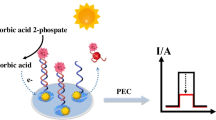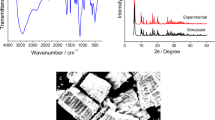Abstract
Using 1,4-Benzenedicarboxylic acid (H2BDC) as the ligand, a kind of copper-based metal-organic frameworks (MOFs) were prepared and characterized using transmission electron microscopy, scanning electron microscopy, infrared spectroscopy, and X-ray diffraction. After that, the prepared Cu-BDC frameworks were used to modify the carbon paste electrode, constructing a novel electrochemical sensor for estradiol (E2). The prepared Cu-BDC frameworks are much more active for the oxidation of E2, and greatly increase the oxidation signals of E2. The results from chronocoulometry indicate that the Cu-BDC frameworks modified electrode exhibit much higher accumulation efficiency toward E2. Based on the signal amplification strategy of Cu-BDC frameworks, a sensitive and rapid electrochemical method was developed for the determination of E2. The linear range was from 5.00 to 650.0 nM, and the detection limit was as low as 3.80 nM. It was used in different water samples, and the values of recovery were over the range from 96.5 to 101%. The practical applications reveal that this new sensing system is accurate and convenient, and has great potential applications in the environmental monitoring.








Similar content being viewed by others
References
Tyler CR, Filby AL, Bickley LK, Cumming RI, Gibson R, Labadie P, Katsu Y, Liney KE, Shears JA, Silva-Castro V, Urushitani H, Lange A, Winter MJ, Iguchi T, Hill EM (2009) Environmental health impacts of equine estrogens derived from hormone replacement therapy. Environ Sci Technol 43:3897–3904
Soto AM, Sonnenschein C (2010) Environmental causes of cancer: endocrine disruptors as carcinogens. Nat Rev Endocrinol 6:364–371
Cesarino I, Hummelgen IA (2015) An additional tool towards overcoming absence of specificity of carbon nanostructure-based electrochemical sensors-application to estriol and estradiol detection and distinction. J Solid State Electrochem 19:3045–3050
Perez C, Simoes FR, Codognoto L (2016) Voltammetric determination of 17 alpha-ethinylestradiol hormone in supply dam using BDD electrode. J Solid State Electrochem 20:2471–2478
Novakova L, Solich P, Matysova L, Sicha J (2004) HPLC determination of estradiol, its degradation product, and preservatives in new topical formulation Estrogel HBF. Anal Bioanal Chem 379:781–787
Tong P, Kasuga Y, Khoo CS (2006) Liquid chromatographic-mass spectrometric method for detection of estrogen in commercial oils and in fruit seed oils. J Food Compos Anal 19:150–156
Medeiros NG, Ribas VC, Lavayen V, Da Silva JA (2016) Synthesis of flower-like Cuo hierarchical nanostructures as an electrochemical platform for glucose sensing. J Solid State Electrochem 20:2419–2426
Yang YJ, Li WK, Chen XH (2012) Highly enhanced electrocatalytic oxidation of glucose on Cu(OH)2/CuO nanotube arrays modified copper electrode. J Solid State Electrochem 16:2877–2881
Liang X, Zhang XY, Wang FW, Xu M, Bao X (2014) Simultaneous determination of guanine and adenine on CuO shuttle-like nanocrystals/poly(neutral red) film on glassy carbon electrode. J Solid State Electrochem 18:3453–3461
Moraes FC, Rossi B, Donatoni MC, de Oliveira KT, Pereira EC (2015) Sensitive determination of 17 beta-estradiol in river water using a graphene based electrochemical sensor. Anal Chim Acta 881:37–43
Yuan LH, Zhang J, Zhou P, Chen JX, Wang RY, Wen TT, Li Y, Zhou XM, Jiang HJ (2011) Electrochemical sensor based on molecularly imprinted membranes at platinum nanoparticles-modified electrode for determination of 17 beta-estradiol. Biosens Bioelectron 29:29–33
Janegitz BC, dos Santos FA, Faria RC, Zucolotto V (2014) Electrochemical determination of estradiol using a thin film containing reduced graphene oxide and dihexadecylphosphate. Mater Sci Eng C-Mater Biol Appl 37:14–19
He Q, Yuan S, Chen C, Hu SS (2003) Electrochemical properties of estradiol at glassy carbon electrode modified with nano-Al2O3 film. Mater Sci Eng C-Mater Biol Appl 23:621–625
Song JC, Yang J, Hu XM (2008) Electrochemical determination of estradiol using a poly(L-serine) film-modified electrode. J Appl Electrochem 38:833–836
Huang XC, Lin YY, Zhang JP, Chen XM (2006) Ligand-directed strategy for zeolite-type metal-organic frameworks: Zinc(II) imidazolates with unusual zeolitic topologies. Angew Chem Int Edit 45:1557–1559
Horcajada P, Gref R, Baati T, Allan PK, Maurin G, Couvreur P, Frey G, Morris RE, Serre C (2012) Metal-organic frameworks in biomedicine. Chem Rev 112:1232–1268
Ji LD, Wang YY, Wu KB, Zhang WK (2016) Simultaneous determination of environmental estrogens: diethylstilbestrol and estradiol using Cu-BTC frameworks-sensitized electrode. Talanta 159:215–221
Ji LD, Cheng Q, Wu KB, Yang XF (2016) Cu-BTC frameworks-based electrochemical sensing platform for rapid and simple determination of sunset yellow and tartrazine. Sensors Actuators B Chem 231:12–17
Anbia M, Sheykhi S (2013) Preparation of multi-walled carbon nanotube incorporated MIL-53-Cu composite metal-organic framework with enhanced methane sorption. J Ind Eng Chem 19:1583–1586
Domenech A, Garcia AH, Domenech-Carbo MT, Xamena FXLI (2006) Electrochemistry nanometric patterning of MOF particles: anisotropic metal electrodeposition in Cu/MOF. Electrochem Commun 8:1830–1834
Acknowledgments
Funding information
This work was Granted by the Opening Project of Zhejiang Provincial Top Key Discipline of Pharmaceutical Sciences (YKFJ3-003), and the National Natural Science Foundation of China (No. 21445003).
Author information
Authors and Affiliations
Corresponding author
Rights and permissions
About this article
Cite this article
Sun, D., Deng, Q. & Long, J. Highly sensitive electrochemical sensor for estradiol based on the signal amplification strategy of Cu-BDC frameworks. J Solid State Electrochem 22, 487–493 (2018). https://doi.org/10.1007/s10008-017-3778-x
Received:
Revised:
Accepted:
Published:
Issue Date:
DOI: https://doi.org/10.1007/s10008-017-3778-x




